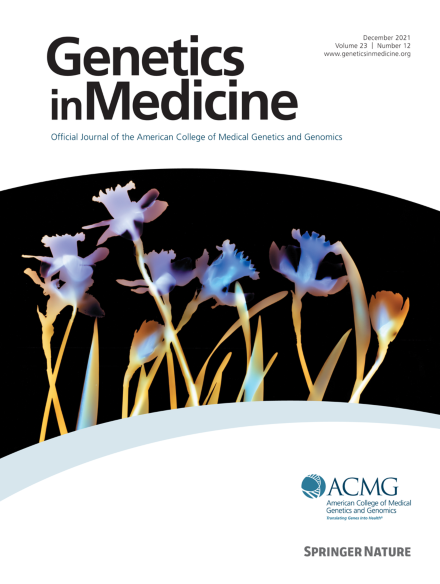Utilization of a SNP microarray to detect uniparental disomy: Implications and outcomes
IF 6.6
1区 医学
Q1 GENETICS & HEREDITY
引用次数: 0
Abstract
Purpose
To examine the utility of single-nucleotide polymorphisms (SNP) microarray analysis to detect uniparental disomy (UPD) by utilizing trios and duos (for which only 1 parent is available).
Methods
We established Mendelian Inheritance Error (MIE) values associated with either UPD or biparental inheritance in a cohort of 124 patients. In duos, the percentage of proband heterozygous (AB) SNPs contributed from the parent submitted was also used to detect UPD.
Results
Examination of 25 trios revealed UPD with a MIE = 0.02 +/− 0.02 and a range of 0.01 to 0.23 for the contributing parent and a MIE = 8.76 +/− 1.68 with a range of 5.96 to 11.14 for the noncontributing parent. Detailed examination of 13 duos (involving 16 chromosomes) showed an AB% = 52.0% +/− 4.85% consistent with biparental origin of the chromosome of interest. In 6 duos (6 chromosomes), the AB% = 97.2% +/− 2.6% and a range of 92.9% to 99.4% were consistent with UPD.
Conclusion
Our results demonstrate utility of a SNP microarray to detect UPD. Distinct MIE ranges were observed that defined UPD or biparental inheritance. In duos, the AB% calculation effectively detected UPD. The diagnostic yield for UPD testing is significantly decreased when large regions of homozygosity are not detected by routine microarray analysis, which has implications for UPD test ordering practices.
利用 SNP 微阵列检测单亲畸形:影响和结果。
目的:研究单核苷酸多态性 (SNP)研究单核苷酸多态性(SNP)微阵列分析在检测单亲裂殖症(UPD)方面的实用性,方法是利用三联体和二联体(只有父母一方可用):我们在一组 124 名患者中确定了与 UPD 或双亲遗传相关的孟德尔遗传错误 (MIE) 值。在双亲遗传中,提交的父母所贡献的概率性杂合(AB)SNPs 的百分比也用于检测 UPD:结果:对 25 例三联病例进行检查后发现,有贡献的父或母的 UPD MIE = 0.02 +/- 0.02,范围为 0.01 - 0.23;无贡献的父或母的 UPD MIE = 8.76 +/- 1.68,范围为 5.96 - 11.14。对 13 个双生子(涉及 16 条染色体)的详细检查显示,AB% = 52.0% +/-4.85% 与相关染色体的双亲来源一致。6对(6条染色体)的AB% = 97.2% +/- 2.6%和92.9% - 99.4%的范围与UPD一致:我们的研究结果证明了 SNP 微阵列检测 UPD 的实用性。我们观察到了不同的 MIE 范围,这些范围确定了 UPD 或双亲遗传。在双亲中,AB%计算能有效检测出UPD。如果常规微阵列分析不能检测到大面积的同源性区域,那么UPD检测的诊断率就会明显下降,这对UPD检测的订购实践有一定的影响。
本文章由计算机程序翻译,如有差异,请以英文原文为准。
求助全文
约1分钟内获得全文
求助全文
来源期刊

Genetics in Medicine
医学-遗传学
CiteScore
15.20
自引率
6.80%
发文量
857
审稿时长
1.3 weeks
期刊介绍:
Genetics in Medicine (GIM) is the official journal of the American College of Medical Genetics and Genomics. The journal''s mission is to enhance the knowledge, understanding, and practice of medical genetics and genomics through publications in clinical and laboratory genetics and genomics, including ethical, legal, and social issues as well as public health.
GIM encourages research that combats racism, includes diverse populations and is written by authors from diverse and underrepresented backgrounds.
 求助内容:
求助内容: 应助结果提醒方式:
应助结果提醒方式:


